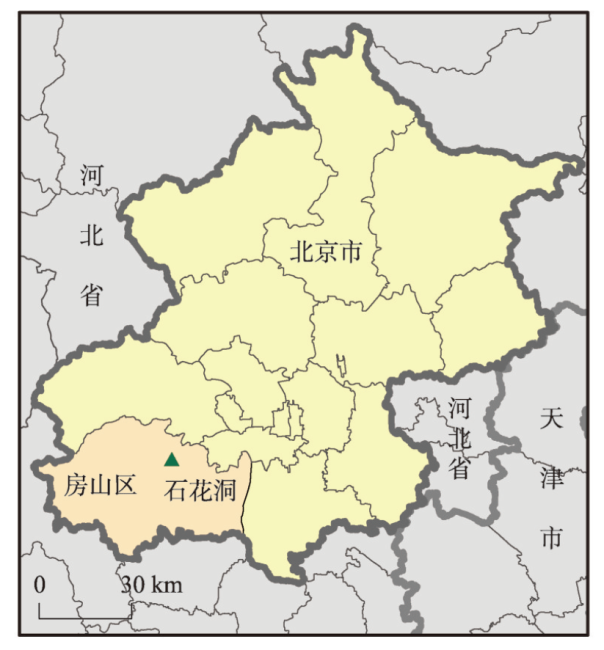

北京石花洞洞穴温湿度变化及其驱动机制
|
班凤梅(1979-), 女, 山西忻州人, 博士, 教授, 研究方向为气候变化和洞穴沉积。E-mail: banfm@sxufe.edu.cn |
收稿日期: 2023-10-18
修回日期: 2024-07-14
网络出版日期: 2024-09-27
基金资助
国家自然科学基金项目(41972191)
山西省回国留学人员科研资助项目(2023-112)
Variation in cave air temperature and humidity and their driving mechanisms in Shihua Cave, Beijing
Received date: 2023-10-18
Revised date: 2024-07-14
Online published: 2024-09-27
Supported by
National Natural Science Foundation of China(41972191)
Shanxi Provincial Scholarship Council of China(2023-112)
洞穴温、湿度是影响石笋生长的重要因素。本文对北京石花洞洞穴温、湿度进行为期43个月的高分辨率(小时)监测分析,探究其发生规律和原因及其与洞内气流活动的关系。结果表明:① 洞穴温、湿度呈现冬春低、夏秋高的季节性变化,洞内温度变化滞后于地表1~3个月,对升温响应慢而对降温响应快,且不同监测点对洞外温度的响应不同。冷季(12月—次年4月),绣花台(XHT)和小蘑菇(XMG)温湿度均呈现下降趋势,二者呈显著正相关;盘龙(PL)点温度变化小且湿度基本处于饱和,二者没有相关性。② 洞内温、湿度日变化季节差异明显,在冷季,PL与XMG点与地表温度日变化相反,白天低夜晚高,而XHT点与地表温度日变化趋势一致;XHT与XMG点与地表湿度日变化一致;暖季(5—11月),洞内与地表温度日变化趋势一致。洞内温、湿度空间变化规律反映了石花洞特殊“楼层式”结构通风的季节性差异以及旅游活动的影响,冬季较强的“烟囱效应”引起的气流活动是洞穴温湿度变化的主要驱动,而在旅游高峰期和游客容易聚集区域,旅游活动的影响显著。本文可以丰富不同洞穴类型下洞内外气流活动的认识,为洞穴石笋的沉积及其古气候反演机理提供重要依据,亦可为旅游洞穴景观保护提供指导。

班凤梅 , 李新越 , 孟浩 , 张蕊 , 陈锋 , 李涛 , 李俊明 , 刘卫婷 , 董瑞 , 毋润民 . 北京石花洞洞穴温湿度变化及其驱动机制[J]. 地理学报, 2024 , 79(9) : 2312 -2323 . DOI: 10.11821/dlxb202409010
In cave environments, the temperature and relative humidity are considered the important factors in the formation of stalagmites. In this study, we introduced a contribution of 43-month duration monitoring records with hourly resolution on temperature and relative humidity, within the Shihua Cave in Beijing, aiming to discern the interplay between these environmental variables and understand their interrelation with the cave dynamics. The observation results are as follows: (1) Cave temperature and relative humidity show the characteristics of low in winter and spring and high in summer and autumn. Notably, the temperature dynamics within the cave exhibited a temporal lag behind surface temperature changes, ranging between 1 to 3 months. This lag contained a gradual response to warming trends and a relatively fast response to cooling trends. Additionally, the response characteristics differ across various monitoring points. In the cold season, both the temperature and humidity at the XHT (Xiuhuatai) and XMG (Xiaomogu) displayed a declining trend and a notable positive correlation. In contrast, the relative humidity levels at the PL (Panlong) remained essentially saturated throughout the year and demonstrated no significant correlation with temperature fluctuations. (2) There are notable seasonal differences in the daily fluctuations of temperature and relative humidity in the cave. In the cold season, the temperature patterns at the PL and XMG monitoring points exhibit a stark contrast to the daily temperature variations on the surface and the relative humidity levels at the XHT and XMG points correspond to the daily fluctuations in surface relative humidity, whereas the XHT points align with the surface temperature trends. In the warm season, the temperature fluctuations at the cave's monitoring points mirror the daily temperature changes on the surface. The significant spatial distribution pattern of temperature and relative humidity in the cave reflects the seasonal differences in airflow activity, influenced by the unique "floor-type" structure of the Shihua Cave, and tourism activities. Airflow activity in the winter mainly affects temperature and humidity changes in the cave. During peak periods and at the attraction, the influence of tourism activities is significant. The findings of this study advanced our understanding of airflow dynamics under the cave setting and established a solid foundation for the cave stalagmite deposition interpretations and their paleoclimate mechanism. Furthermore, this research can serve as valuable guidance for the conservation of tourist cave landscapes.

图3 2020年6月10日—2024年1月10日洞穴空气湿度、温度和大气温度和降水变化注:灰色竖条纹表示洞穴关闭时段;2022年7月17日至2023年3月18日大气温度和降雨量因仪器故障未能获取,北京市大气温度与日降雨量数据来自美国国家海洋和大气管理局(NOAA)国家环境信息中心(NCEI, https://www.noaa.gov/)。 Fig. 3 Time series of the cave air relative humidity, air temperature, atmospheric temperature and precipitation during monitored period from 10 June 2020 to 10 January 2024 |
图7 石花洞3个监测点的洞穴空气温度与游客人数对比注:灰色竖条纹表示疫情期间洞穴关闭时段;红色圆点指示2021年国庆假期温度骤升峰。 Fig. 7 Comparison of cave air temperature and visitor number indicates the impact of human activity on cave environment |
图8 2023年12月XHT点洞穴温度与洞外大气温度变化对比图注:灰色竖条纹表示疫情洞穴关闭期;蓝色竖条纹表示每日14:00—16:00时段。 Fig. 8 Comparison of cave air temperature around site XHT and atmospheric temperature indicates the impact of cave opening and closing on cave environment |
感谢中国科学院地质与地球物理研究所谭明研究员和福建师范大学蔡炳贵教授的有益指导,匿名审稿人提出的宝贵建议。感谢北京市房山世界地质公园管理处肖精武等工作人员、北京市房山区石花洞风景名胜区管理处工作人员对本工作的大力支持。
| [1] |
|
| [2] |
|
| [3] |
[汪永进, 刘殿兵. 亚洲古季风变率和机制的洞穴石笋档案. 科学通报, 2016, 61(9): 938-951.]
|
| [4] |
|
| [5] |
[田怡苹, 李云霞, 光凯悦, 等. 中国石笋生长速率时空变化特征的初步分析. 第四纪研究, 2023, 43(1): 20-32.]
|
| [6] |
|
| [7] |
[田立军, 周厚云, 段武辉. “蒸发效应”对洞穴滴水氧同位素信号传递的影响: 以广东宝晶宫现代观测为例. 第四纪研究, 2013, 33(3): 618-620.]
|
| [8] |
[班凤梅, 蔡炳贵. 北京石花洞空气环境主要因子季节性变化特征研究. 中国岩溶, 2011, 30(2): 132-137.]
|
| [9] |
|
| [10] |
[汪炎林, 周忠发, 薛冰清, 等. 喀斯特关键带水—土—气CO2分压垂直转化特征及影响因素. 地理学报, 2020, 75(5): 1008-1021.]
|
| [11] |
|
| [12] |
|
| [13] |
|
| [14] |
[桑文翠, 张德忠, 王晓锋, 等. 甘肃武都万象洞方解石现代沉积控制因素分析. 第四纪研究, 2013, 33(5): 936-944.]
|
| [15] |
[张美良, 朱晓燕, 吴夏, 等. 旅游活动对巴马水晶宫洞穴环境及碳酸钙沉积物景观的影响. 中国岩溶, 2017, 36(1): 119-130.]
|
| [16] |
[朱晓燕, 张美良. 基于岩溶洞穴旅游活动中洞穴环境因子的研究. 中国岩溶, 2020, 39(3): 426-431.]
|
| [17] |
[殷超, 周忠发, 曹明达, 等. 岩溶洞穴内气候环境因子关系分析: 以贵州省织金洞为例. 中国岩溶, 2016, 35(4): 414-424.]
|
| [18] |
[陈琳, 黄嘉仪, 刘淑华, 等. 广东英德宝晶宫洞穴微环境时空变化特征及其主要影响因素探究. 地球与环境, 2017, 45(2): 164-170.]
|
| [19] |
[潘天望, 史文强, 梁建平, 等. 疫情背景下桂林市芦笛岩空气环境影响因素研究. 中国岩溶, 2021, 40(6): 1006-1013.]
|
| [20] |
[潘艳喜, 周忠发, 张结, 等. 喀斯特旅游洞穴微气候环境要素时空分布特征及影响因素: 以贵州织金洞为例. 科学技术与工程, 2018, 18(10): 20-30.]
|
| [21] |
|
| [22] |
|
| [23] |
|
| [24] |
|
| [25] |
|
| [26] |
|
| [27] |
[班凤梅, 谭明, 韩晋仙, 等. 北京石花洞疏松-致密型石笋微层形成机理. 科学通报, 2019, 64(20): 2134-2140.]
|
| [28] |
|
| [29] |
|
| [30] |
|
| [31] |
|
| [32] |
|
| [33] |
[班凤梅, 潘根兴, 蔡炳贵, 等. 北京石花洞洞穴滴水中硫酸根浓度的时空变化及其意义. 中国岩溶, 2009, 28(3): 243-248.]
|
| [34] |
[刘宏, 郑明存, 段洪伍, 等. 北京石花洞结构特征及发育演化过程研究. 中国岩溶, 2015, 34(1): 27-34.]
|
| [35] |
|
| [36] |
|
| [37] |
[韦跃龙, 陈伟海, 罗劬侃, 等. 洞穴呼吸及其影响因素. 地质科技情报, 2017, 36(4): 82-94.]
|
| [38] |
[范宝祥, 周忠发, 朱粲粲, 等. 短时间尺度下旅游洞穴空气环境自净能力研究: 以绥阳大风洞为例. 中国岩溶, 2020, 39(2): 275-285.]
|
| [39] |
[安丹, 周忠发, 范宝祥, 等. 贵州大风洞洞穴空气CO2浓度及滴水水化学与洞穴通风的响应. 水土保持研究, 2020, 27(6): 338-345, 352.]
|
| [40] |
[石亮星, 周忠发, 范宝祥, 等. 喀斯特洞穴通风效应特征变化及其对洞内空气环境的影响研究: 以贵州绥阳麻黄洞为例. 长江流域资源与环境, 2021, 30(7): 1704-1713.]
|
| [41] |
[张结, 周忠发, 汪炎林, 等. 短时间高强度旅游活动下洞穴CO2的变化特征及对滴水水文地球化学的响应. 地理学报, 2018, 73(9): 1687-1701.]
|
| [42] |
[方龙龙, 刘际松. 浙江桐庐瑶琳洞洞穴气候特征及其分析. 中国岩溶, 1991, 10(1): 72-81.]
|
| [43] |
[罗维均, 王世杰, 刘秀明. 喀斯特洞穴系统碳循环的烟囱效应研究现状及展望. 地球科学进展, 2014, 29(12): 1333-1340.
|
/
| 〈 |
|
〉 |